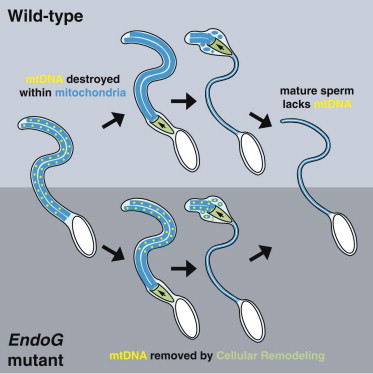Understanding Sperm Cells and Their Composition
Human sperm cells, responsible for the transmission of genetic material from males to females during fertilization, are composed of several essential components. The head, midpiece, and tail collectively facilitate the journey of the sperm towards the egg. Alongside these vital structures, an organelle called mitochondria plays an equally critical role in the reproductive process.

The Mighty Mitochondria: Fueling Sperm Motility
Often referred to as the "powerhouse of the cell," mitochondria are responsible for converting nutrients into usable energy through a process called cellular respiration. While mitochondria are typically inherited only from the mother, sperm cells defy this convention as they contain their own unique mitochondria.
Sperm mitochondria are mainly concentrated in the midpiece of the cell, nestled alongside the flagellum, which propels the sperm forward. This strategic placement allows mitochondria to provide the necessary energy for sperm motility, enabling them to swim through the female reproductive tract towards the egg.
Why Do Sperm Need Their Own Mitochondria?
Since mitochondria are typically inherited from the mother, one might wonder why sperm possess their own mitochondria. The answer lies in the fact that the maternal mitochondria found in the fertilized egg are selectively segregated, mainly in the embryo and not in the sperm. This process ensures that the mitochondria present within the sperm do not interfere with the genetic information conveyed to future generations.
Moreover, sperm-specific mitochondria are essential for the survival and functionality of the sperm cells themselves. These mitochondria fulfill the enormous energy requirements necessary for sperm development, maturation, and penetration of the egg's protective layers. Without their mitochondria, sperm would lack the energy supply crucial for fertilization.
The Implications for Male Fertility
Given the significance of mitochondria in sperm functionality, any abnormalities within these organelles can have profound implications for male fertility. Defects in sperm mitochondria or a decline in their function can lead to reduced sperm motility, impaired fertilization, and increased risk of pregnancy loss.
Advancements in reproductive medicine are increasingly exploring the relationship between mitochondrial health and male fertility. By understanding the role of mitochondria in sperm cells, researchers can enhance diagnostic techniques and develop new treatments to address mitochondrial-related infertility issues.
In Conclusion
While mitochondria are primarily associated with energy production in cells, sperm cells possess their own unique mitochondria that contribute to their essential function—motility. Understanding the crucial role mitochondria play in sperm cells not only sheds light on the wonders of human reproduction but also holds promise for developing innovative approaches to male infertility.
Next time you ponder the origins of life, remember the mighty mitochondria powering sperm towards the union of life itself.
Related FAQs about do sperm have mitochondria
Do sperm have mitochondria?
Yes, sperm cells do have mitochondria.
Where are the mitochondria located in sperm cells?
The mitochondria in sperm cells are primarily concentrated in the midpiece, which is located behind the head and adjacent to the flagellum (tail).
Why do sperm need their own mitochondria?
Sperm possess their own mitochondria to ensure that the genetic information conveyed to future generations remains intact. They also provide the energy required for sperm development, maturation, and motility.
What happens if there are abnormalities in sperm mitochondria?
Abnormalities in sperm mitochondria can lead to reduced sperm motility, impaired fertilization, and an increased risk of pregnancy loss.
How does understanding sperm mitochondria help with male fertility?
Understanding the role of mitochondria in sperm cells allows researchers to develop enhanced diagnostic techniques and potential treatments for addressing mitochondrial-related infertility issues in males.
Glossary about do sperm have mitochondria
1. Mitochondria: Mitochondria are double-membraned organelles found in eukaryotic cells. They are responsible for converting nutrients into usable energy through a process called cellular respiration.
2. Cellular respiration: Cellular respiration is the process by which cells convert nutrients into energy in the form of adenosine triphosphate (ATP). It occurs within the mitochondria and involves the breakdown of glucose or other organic molecules.
3. Sperm cells: Sperm cells, also known as spermatozoa, are the male reproductive cells responsible for fertilizing the egg. They consist of a head, midpiece, and tail, and are specialized for motility.
4. Midpiece: The midpiece is a region of the sperm cell located between the head and the tail. It contains mitochondria that provide energy for sperm motility.
5. Flagellum: The flagellum is a tail-like structure found in sperm cells that enables them to swim. It is powered by the energy produced by mitochondria in the midpiece of the cell.
6. Fertilization: Fertilization is the process in which a sperm cell fuses with an egg cell, resulting in the formation of a zygote. This marks the beginning of embryonic development.
7. Embryo: An embryo is the early stage of development of a multicellular organism. In the context of human reproduction, it refers to the developing organism after fertilization and implantation in the uterus.
8. Male fertility: Male fertility refers to a man's ability to impregnate a woman and achieve successful pregnancy. It is influenced by various factors, including sperm quality, sperm count, and sperm motility.
9. Reproductive medicine: Reproductive medicine is a branch of medicine that focuses on diagnosing and treating fertility problems and disorders related to reproductive health. It encompasses techniques and technologies aimed at assisting reproductive processes.
10. Infertility: Infertility refers to the inability to conceive or produce offspring despite regular sexual activity without contraception. It can be attributed to various factors, including issues with sperm production, sperm function, or reproductive organs.
